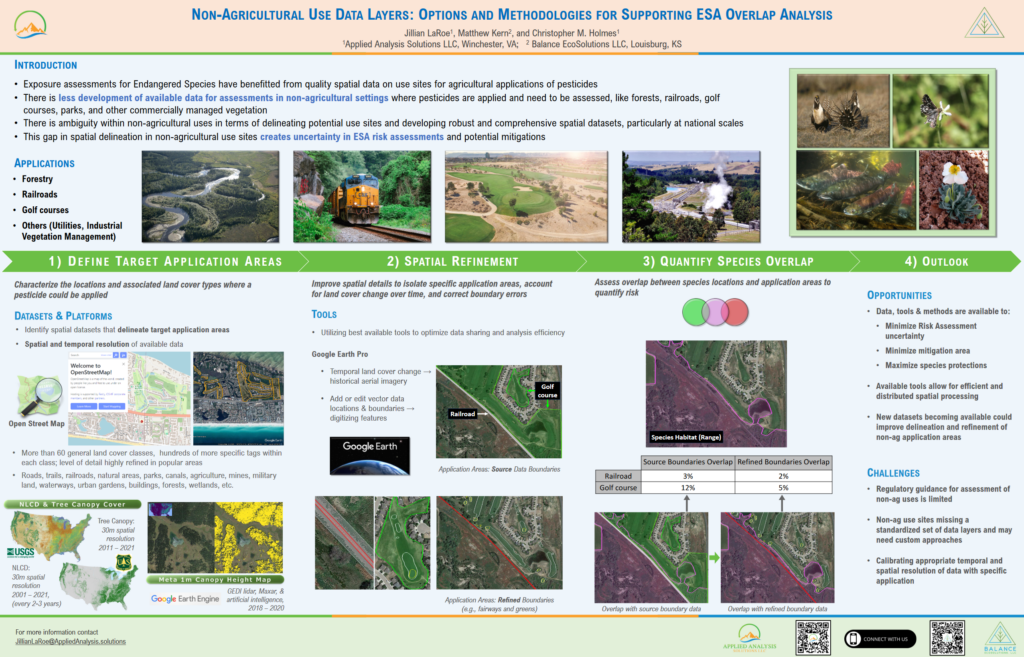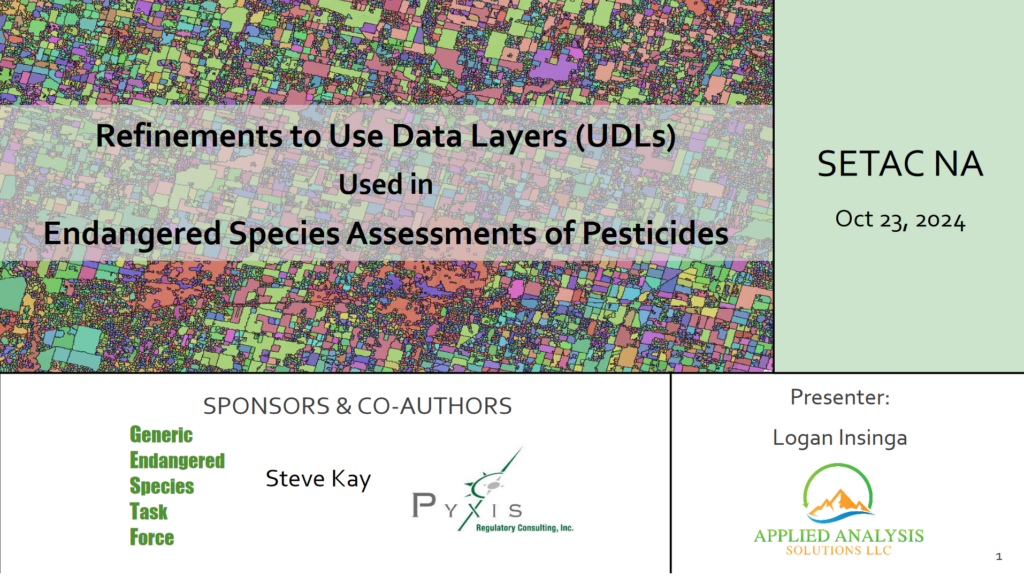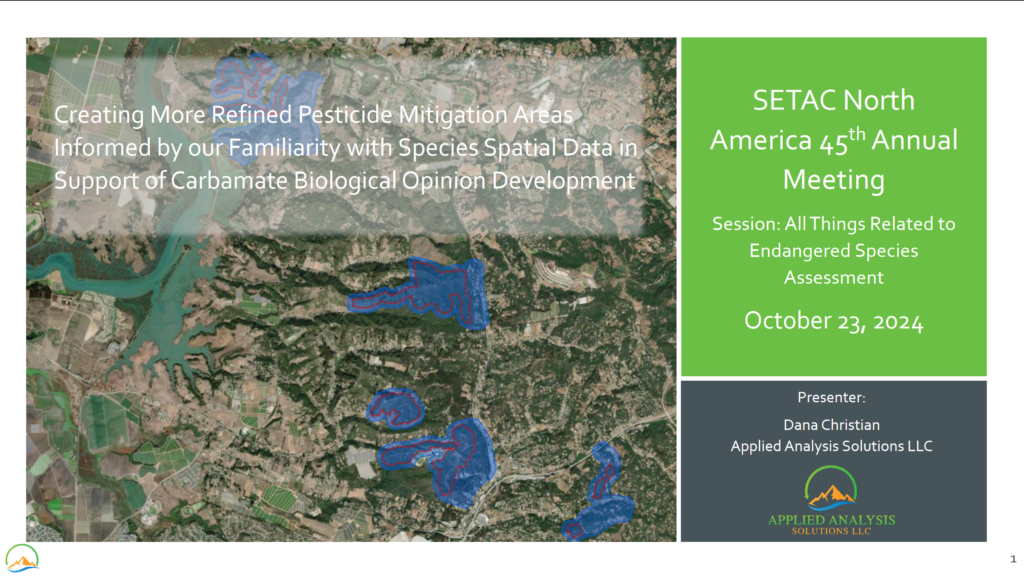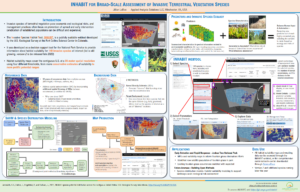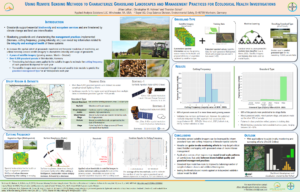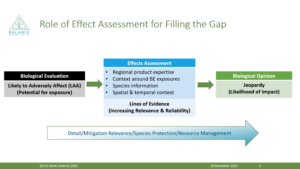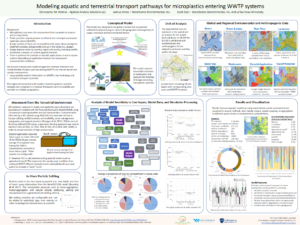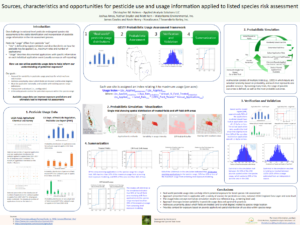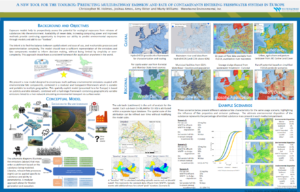2024
LaRoe, J. (Applied Analysis Solutions, LLC); Kern, M. (Balance EcoSolutions, LLC); Holmes, C.M. (Applied Analysis Solutions, LLC)
Non-Agricultural Use Data Layers: Options and Methodologies for Supporting ESA Overlap Analysis Presentation
10.20.2024.
Abstract | Links | Tags: 2024, Poster, SETAC North America
@misc{NA24UDL,
title = {Non-Agricultural Use Data Layers: Options and Methodologies for Supporting ESA Overlap Analysis},
author = {LaRoe, J. (Applied Analysis Solutions, LLC) and Kern, M. (Balance EcoSolutions, LLC) and Holmes, C.M. (Applied Analysis Solutions, LLC)},
url = {https://appliedanalysis.solutions/wp-content/uploads/2024/10/SETAC-NA-2024-NonAgricultural-Use-Data-Layers-Options-and-Methodologies.pdf, View Poster},
year = {2024},
date = {2024-10-20},
urldate = {2024-10-20},
abstract = {Exposure assessments for Endangered Species have benefitted from quality spatial data on use sites for agricultural applications of pesticides. There is less development of available data for assessments in non-agricultural settings where pesticides are applied and need to be assessed, like forests, railroads, golf courses, parks, and other commercially managed vegetation. The emphasis on agricultural use sites has produced refined methodologies as well as defined and delineated data sets (e.g., Use Data Layers). However, there is ambiguity within non-agricultural uses in terms of delineating potential use sites and developing robust and comprehensive spatial datasets, particularly at national scales. Recent advancements in data processing/platforms along with the scale and extent of available spatial data present an opportunity to develop more comprehensive datasets for non-agricultural overlap analyses (relationship of use sites to species habitats). We have created customized approaches leveraging detailed datasets, like Open Street Map, to help fill this data gap. We incorporated additional information from other sources, such as historical high resolution aerial imagery, to support boundary editing and refinement of application areas. We present a combination of data sources and methods that can be tailored to curate data for specific objectives, tools and strategies to refine potential exposure for non-agricultural scenarios, as well as applied examples using golf courses, railroad vegetation management, and forests.},
keywords = {2024, Poster, SETAC North America},
pubstate = {published},
tppubtype = {presentation}
}
Insinga, L. (Applied Analysis Solutions, LLC); Kay, S. (Pyxis Regulatory Consulting, Inc)
Refinements to Use Data Layers (UDLs) Used in Endangered Species Assessments of Pesticides Presentation
10.20.2024.
Abstract | Links | Tags: 2024, Presentation, SETAC North America
@misc{2024NA-CSB,
title = {Refinements to Use Data Layers (UDLs) Used in Endangered Species Assessments of Pesticides},
author = {Insinga, L. (Applied Analysis Solutions, LLC) and Kay, S. (Pyxis Regulatory Consulting, Inc)},
url = {https://appliedanalysis.solutions/wp-content/uploads/2024/10/SETAC-NA-2024-CSB-Based-UDLs.pdf, View Presentation},
year = {2024},
date = {2024-10-20},
urldate = {2024-10-20},
abstract = {In their Endangered Species (ES) assessments for pesticides, the US Environmental Protection Agency (EPA), US Fish and Wildlife Service (FWS) and National Marine Fisheries Service (NMFS) use datasets called Use Data Layers (UDLs) to spatially delineate potential pesticide use sites. For agricultural uses, the UDLs are currently generated from the US Department of Agriculture’s (USDA) Cropland Data Layer (CDL) raster dataset, which is created using a machine learning classification algorithm applied to satellite imagery, agricultural ground truth data, and other ancillary datasets. The current approach for generating agricultural UDLs sources 5 years of CDL datasets which are processed by grouping the more than 100 individual CDL cultivated classes into 13 general UDL classes. While this approach is robust, there are some challenges. One challenge with generating agricultural UDLs is the presence of “spurious pixels” or highly fragmented areas of the UDL that are known to be false-positive classifications (i.e., non-agricultural raster cells classified as agriculture) carried through from the source CDL dataset. The presence of spurious pixels can result in inaccurate estimations of co-occurrence between UDLs and listed species locations, and it is desirable to remove spurious pixels to the greatest extent possible. However, it is difficult to identify and filter spurious pixels in a programmatic way given the nature of the remotely sensed source dataset. Furthermore, it is undesirable to remove actual agriculture from the UDLs, which can occur if agricultural pixels are misidentified as spurious. To address this issue, we propose to mitigate the presence of spurious pixels by incorporating additional processing steps to generate more accurate UDLs. This method builds on the USDA’s refinement of the base raster CDL data into a vector Crop Sequence Boundary (CSB) dataset that uses publicly available data and employs a transparent yet efficient processing workflow. This new methodology virtually eliminates spurious pixels from the UDLs and provides the added benefit of significantly improved processing efficiency leading to a reduction in processing time from weeks for the original CDL based approach to overnight using the new CSB based approach.},
keywords = {2024, Presentation, SETAC North America},
pubstate = {published},
tppubtype = {presentation}
}
Christian, D. (Applied Analysis Solutions, LLC); Kern, M. (Balance EcoSolutions, LLC); Holmes, C.M. (Applied Analysis Solutions, LLC); Kay, S. (Pyxis Regulatory Consulting, Inc); Cowles, J. (Tessenderlo Kerley, Inc.); Henry, K. (Tessenderlo Kerley, Inc.)
10.20.2024.
Abstract | Links | Tags: 2024, Presentation, SETAC North America
@misc{2024NA-PULAs,
title = {Creating More Refined Pesticide Mitigation Areas Informed by Our Familiarity With Species Spatial Data in Support of Carbamate Biological Opinion Development},
author = {Christian, D. (Applied Analysis Solutions, LLC) and Kern, M. (Balance EcoSolutions, LLC) and Holmes, C.M. (Applied Analysis Solutions, LLC) and Kay, S. (Pyxis Regulatory Consulting, Inc) and Cowles, J. (Tessenderlo Kerley, Inc.) and Henry, K. (Tessenderlo Kerley, Inc.)},
url = {https://appliedanalysis.solutions/wp-content/uploads/2024/10/SETAC-NA-2024-PULAs-Carbamate-BO.pdf, View Presentation},
year = {2024},
date = {2024-10-20},
abstract = {Pesticide mitigation areas are designed to ensure a pesticide’s use will be protective of listed endangered or threatened species and their critical habitat. A species range can be geographically broad and can include areas unsuitable for habitat due to various environmental factors. There is a need to create more spatially refined pesticide mitigation areas (e.g., Pesticide Use Limitation Areas, PULAs) to better identify habitats where mitigation may be required. We have implemented a process during recent work with carbamates which has allowed us to explore more detailed habitat definitions to refine areas within a species range that, according to the most recent documentation from FWS, are required for a species’ continued recovery. We have worked to develop a “core map” representing locations of the species where mitigations are needed based on species range, critical habitat, known locations, and suitable habitat. We have focused on using the best publicly available spatial datasets in conjunction with the most recent FWS species documentation to build detailed core maps for a wide variety of endangered species. Experience has shown us that, while challenges with resources and uncertainty exist, this range refinement process is possible and valuable for assessment of risk to many endangered species. This presentation lays out the lessons learned and choices made while developing more refined pesticide mitigation areas, based on our extensive experience with species range, critical habitat, potentially suitable habitat and known locations in support of the carbamate BOs.},
keywords = {2024, Presentation, SETAC North America},
pubstate = {published},
tppubtype = {presentation}
}
2022
Holmes, C.M. (Applied Analysis Solutions, LLC); Schad, T. (Bayer AG); Preuss, T. (University of Koblenz-Landau, Germany)
Scenario Development for Bee Risk Assessment and Health Modelling Presentation
11.13.2022.
Links | Tags: 2022, Poster, SETAC North America
@misc{NA2022Bee,
title = {Scenario Development for Bee Risk Assessment and Health Modelling},
author = {Holmes, C.M. (Applied Analysis Solutions, LLC) and Schad, T. (Bayer AG) and Preuss, T. (University of Koblenz-Landau, Germany)},
url = {https://appliedanalysis.solutions/wp-content/uploads/2023/08/SETAC-NA-2022-BeeForage.pdf, View Poster},
year = {2022},
date = {2022-11-13},
urldate = {2022-11-13},
keywords = {2022, Poster, SETAC North America},
pubstate = {published},
tppubtype = {presentation}
}
LaRoe, J. (Applied Analysis Solutions, LLC)
INHABIT for Broad-Scale Assessment of Invasive Terrestrial Vegetation Species Presentation
11.13.2022.
Links | Tags: 2022, Poster, SETAC North America
@misc{NA2022INHABIT,
title = {INHABIT for Broad-Scale Assessment of Invasive Terrestrial Vegetation Species},
author = {LaRoe, J. (Applied Analysis Solutions, LLC)},
url = {https://appliedanalysis.solutions/wp-content/uploads/2023/08/SETAC-NA-2022-INHABIT.pdf, View Poster},
year = {2022},
date = {2022-11-13},
urldate = {2022-11-13},
keywords = {2022, Poster, SETAC North America},
pubstate = {published},
tppubtype = {presentation}
}
LaRoe, J. (Applied Analysis Solutions, LLC); Holmes, C.M. (Applied Analysis Solutions, LLC); Schad, T. (Bayer AG)
11.13.2022.
Links | Tags: 2022, Poster, SETAC North America
@misc{NA2022Grassland,
title = {Using Remote Sensing Methods to Characterize Grassland Landscapes and Management Practices for Ecological Health Investigations},
author = {LaRoe, J. (Applied Analysis Solutions, LLC) and Holmes, C.M. (Applied Analysis Solutions, LLC) and Schad, T. (Bayer AG)},
url = {https://appliedanalysis.solutions/wp-content/uploads/2023/08/SETAC-NA-2022-Characterize-Grassland.pdf, View Poster},
year = {2022},
date = {2022-11-13},
urldate = {2022-11-13},
keywords = {2022, Poster, SETAC North America},
pubstate = {published},
tppubtype = {presentation}
}
2020
Holmes, C.M. (Applied Analysis Solutions, LLC); Pearson, R. (Southern Illinois University Edwardsville); Pritsolas, J. (Southern Illinois University Edwardsville); Butts-Wilmsmeyer, C. (Southern Illinois University Edwardsville); Schad, T. (Bayer CropScience)
Informing Effects Modeling Using Historic Changes in Habitat Derived from Remote Sensing Presentation
11.15.2020.
Abstract | Links | Tags: 2020, Presentation, SETAC North America
@misc{2020NAIE,
title = {Informing Effects Modeling Using Historic Changes in Habitat Derived from Remote Sensing},
author = {Holmes, C.M. (Applied Analysis Solutions, LLC) and Pearson, R. (Southern Illinois University Edwardsville) and Pritsolas, J. (Southern Illinois University Edwardsville) and Butts-Wilmsmeyer, C. (Southern Illinois University Edwardsville) and Schad, T. (Bayer CropScience)},
url = {https://www.youtube.com/watch?v=vvEMOeC50mw, Presentatio video},
year = {2020},
date = {2020-11-15},
urldate = {2020-11-15},
abstract = {Ecological effects modeling for population or community level environmental risk assessment seeks to describe the interactions of biological, chemical, environmental and anthropogenic factors in relation to stressor-response relationships. Changes in landscape over time can play a large role in habitat suitability and species occurrence, important aspects in population-level modeling. Landscape change can be assessed from retrospective analyses or predictive efforts based on models or assumptions.
This presentation describes novel remote sensing image processing methods used to capture landscape-level changes in grassland extent and management within a 300 km2 area over a 25-year period near Krefeld, Germany. Over 150 satellite images were acquired from NOAA’s Landsat program spanning 1989 to 2013 from all seasons. Images within each year were normalized for atmospheric and illumination variation to focus on vegetation changes due to plant structure and vigor using different vegetation indices based on visible and infra-red wavelengths.
Four groups of grassland fields were identified using a k-means clustering algorithm based on spectral information. In several groups, periods of distinct increase in vegetation biomass (defined by vegetation indices) could indicate changes in grassland management practices over that time from natural grassland cycles to include more intensive management activities (e.g., fertilization, more frequent cutting, silage production). Other groups showed relative consistency across time.
All data used in this study are geographically referenced and processed in a Geographic Information System (GIS). These data are suitable for spatially-explicit landscape-level ecological modeling efforts exploring the multitude of stressors that may impact biological communities over time. This is especially important for retrospective modeling studies where ecological models are used to explain empirically derived data over time (e.g., sampling of insect counts and biomass). Grassland areas are important habitat for some groups of insects and understanding historic changes in grassland extent and management provides a key factor in the study of landscape-level ecological effects modeling. We have demonstrated the feasibility and applicability of utilizing information from freely available satellite image archives for habitat characterization of historic landscape patterns and changes over a 25-year period.},
keywords = {2020, Presentation, SETAC North America},
pubstate = {published},
tppubtype = {presentation}
}
This presentation describes novel remote sensing image processing methods used to capture landscape-level changes in grassland extent and management within a 300 km2 area over a 25-year period near Krefeld, Germany. Over 150 satellite images were acquired from NOAA’s Landsat program spanning 1989 to 2013 from all seasons. Images within each year were normalized for atmospheric and illumination variation to focus on vegetation changes due to plant structure and vigor using different vegetation indices based on visible and infra-red wavelengths.
Four groups of grassland fields were identified using a k-means clustering algorithm based on spectral information. In several groups, periods of distinct increase in vegetation biomass (defined by vegetation indices) could indicate changes in grassland management practices over that time from natural grassland cycles to include more intensive management activities (e.g., fertilization, more frequent cutting, silage production). Other groups showed relative consistency across time.
All data used in this study are geographically referenced and processed in a Geographic Information System (GIS). These data are suitable for spatially-explicit landscape-level ecological modeling efforts exploring the multitude of stressors that may impact biological communities over time. This is especially important for retrospective modeling studies where ecological models are used to explain empirically derived data over time (e.g., sampling of insect counts and biomass). Grassland areas are important habitat for some groups of insects and understanding historic changes in grassland extent and management provides a key factor in the study of landscape-level ecological effects modeling. We have demonstrated the feasibility and applicability of utilizing information from freely available satellite image archives for habitat characterization of historic landscape patterns and changes over a 25-year period.
Kern, M. (Balance EcoSolutions, LLC); Holmes, C.M. (Applied Analysis Solutions, LLC); Kay, S. (Pyxis Regulatory Consulting, Inc); Cowles, J. (Tessenderlo Kerley, Inc.); Henry, K. (Tessenderlo Kerley, Inc.)
Advancing Beyond the Draft Biological Evaluation of Carbaryl for Federally Listed Species Presentation
11.15.2020.
Abstract | Links | Tags: 2020, Presentation, SETAC North America
@misc{2020NAAB,
title = {Advancing Beyond the Draft Biological Evaluation of Carbaryl for Federally Listed Species},
author = {Kern, M. (Balance EcoSolutions, LLC) and Holmes, C.M. (Applied Analysis Solutions, LLC) and Kay, S. (Pyxis Regulatory Consulting, Inc) and Cowles, J. (Tessenderlo Kerley, Inc.) and Henry, K. (Tessenderlo Kerley, Inc.)},
url = {https://www.youtube.com/watch?v=Pw_V_MXP3f8, Presentation video},
year = {2020},
date = {2020-11-15},
urldate = {2020-11-15},
abstract = {The Endangered Species Act (ESA) requires federal agencies to ensure that their actions are not likely to jeopardize the continued existence, nor destroy or adversely modify the designated critical habitat, of species listed as threatened or endangered under the ESA. For pesticides, a Biological Evaluation (BE) is conducted by the EPA as a first step in the ESA assessment. If EPA’s BE determines a pesticide may affect a listed species or its designated critical habitat, EPA must initiate consultation with the U.S. Fish and Wildlife Service and/or the National Marine Fisheries Service (Services) depending on which agency has jurisdiction over the species.
On March 17, 2020, EPA posted to the Federal Register (FRL-10006-38) the release of their draft Biological Evaluation (BE) assessing potential risks to listed species from labeled uses of carbaryl. In parallel, the EPA posted a Revised Method document (EPA-HQ-OPP-2019-0195) detailing updated methods for conducting a BE. The revised methods include the use of actual pesticide usage data and distribution of treated acres, alternate assumptions for species population numbers, probabilistic approaches, and a weight-of-evidence framework for making effect determinations. As noted in the BE, the methods used in these analyses continue to evolve over time.
To further support this advancement, case studies implementing the Revised Methods were conducted to understand and evaluate the approaches used in the draft BE for carbaryl. To increase the reliability and relevance of the assessment, this work also considered additional methods and lines of evidence to reduce uncertainty. Central to this approach is analyzing potential impacts to a species for individual use patterns and including species specific information. The transparency and availability of information from the full BE analysis is critical to support the Services in jeopardy determinations. The case studies demonstrate the need to bring as many relevant and realistic lines of evidence into the assessment as early as possible to help advance the evaluation of risk to listed species and inform the development of the Biological Opinion (BO) for carbaryl.},
keywords = {2020, Presentation, SETAC North America},
pubstate = {published},
tppubtype = {presentation}
}
On March 17, 2020, EPA posted to the Federal Register (FRL-10006-38) the release of their draft Biological Evaluation (BE) assessing potential risks to listed species from labeled uses of carbaryl. In parallel, the EPA posted a Revised Method document (EPA-HQ-OPP-2019-0195) detailing updated methods for conducting a BE. The revised methods include the use of actual pesticide usage data and distribution of treated acres, alternate assumptions for species population numbers, probabilistic approaches, and a weight-of-evidence framework for making effect determinations. As noted in the BE, the methods used in these analyses continue to evolve over time.
To further support this advancement, case studies implementing the Revised Methods were conducted to understand and evaluate the approaches used in the draft BE for carbaryl. To increase the reliability and relevance of the assessment, this work also considered additional methods and lines of evidence to reduce uncertainty. Central to this approach is analyzing potential impacts to a species for individual use patterns and including species specific information. The transparency and availability of information from the full BE analysis is critical to support the Services in jeopardy determinations. The case studies demonstrate the need to bring as many relevant and realistic lines of evidence into the assessment as early as possible to help advance the evaluation of risk to listed species and inform the development of the Biological Opinion (BO) for carbaryl.
Holmes, C.M. (Applied Analysis Solutions, LLC); Tandy, E. (Applied Analysis Solutions, LLC); Schleicher, Z. (Southern Illinois University, Edwardsville); Kilgallon, J. (Unilever Safety & Environmental Assurance Centre); Speirs, L. (Unilever Safety & Environmental Assurance Centre); Hodges, J. (Unilever Safety & Environmental Assurance Centre)
11.15.2020.
Abstract | Links | Tags: 2020, Presentation, SETAC North America
@misc{2020NAMarine,
title = {Marine Emissions From Municipal Treatment Plants: Refining Our Understanding and Defining Spatial Variability at a Global Scale},
author = {Holmes, C.M. (Applied Analysis Solutions, LLC) and Tandy, E. (Applied Analysis Solutions, LLC) and Schleicher, Z. (Southern Illinois University, Edwardsville) and Kilgallon, J. (Unilever Safety & Environmental Assurance Centre) and Speirs, L. (Unilever Safety & Environmental Assurance Centre) and Hodges, J. (Unilever Safety & Environmental Assurance Centre)},
url = {https://www.youtube.com/watch?v=i3L-9_ySzmo, Presentation video},
year = {2020},
date = {2020-11-15},
urldate = {2020-11-15},
abstract = {Pharmaceuticals, pesticides, biocides, and ingredients in home and personal care products are often disposed of via waste water. This can lead to exposure of aquatic ecosystems through discharge from municipal wastewater treatment plants (WWTPs). Aquatic exposure models primarily focus on freshwater systems and often address marine exposures simply as a variation of a freshwater scenario (e.g., by increasing the dilution factor). However, the average population density in coastal areas is now twice the world’s average population density, and many of the world’s coasts are becoming increasingly urban (14 of the world’s 17 largest cities are coastal located). Thus developing a better understanding of marine emissions is thus becoming increasingly important.
The aim of this research is to develop and analyze a global-scale dataset focusing on marine emissions (i.e., near shore coastal waters) with the goal of understanding what fraction of the population in coastal areas may be discharging directly to marine environments. The ultimate goal is to couple this information with environmental exposure models using spatially-explicit information on substance uses, pathways to the environment, and eventual fate in aquatic ecosystems.
Information on WWTP location, population served, and effluent flow were collected for 44,000 WWTPs across seven case studies (AU, BR, CA, EU, MX, SG, and US) covering all four hemispheres (North/South, East/West) for over one billion people. WWTPs were attributed as discharging to coastal waters (CW) from source data or analysis of receiving waterbody. Spatial analysis showed that WWTPs for 27% of the population served are within 10km of the coast. Global hydrologic data were used to identify 50,000 basins with the potential to discharge to coastal waters. Basins within our seven case studies were analyzed to characterize the WWTPs and population in terms of CW discharge. Of the 258,000 people in these coastal basins served by WWTPs, 50% are served by WWTPs discharging to coastal waters. Spatial population data were used to characterize coastal basins globally, with results extrapolated to other countries, to assess the potential for marine emissions using data on basins, distance to coast, gridded population, and urban delineations.
This is a novel step forward in understanding potential global-scale marine emissions from WWTPs with the goal of balancing realism and practical applicability in environmental safety programs.},
keywords = {2020, Presentation, SETAC North America},
pubstate = {published},
tppubtype = {presentation}
}
The aim of this research is to develop and analyze a global-scale dataset focusing on marine emissions (i.e., near shore coastal waters) with the goal of understanding what fraction of the population in coastal areas may be discharging directly to marine environments. The ultimate goal is to couple this information with environmental exposure models using spatially-explicit information on substance uses, pathways to the environment, and eventual fate in aquatic ecosystems.
Information on WWTP location, population served, and effluent flow were collected for 44,000 WWTPs across seven case studies (AU, BR, CA, EU, MX, SG, and US) covering all four hemispheres (North/South, East/West) for over one billion people. WWTPs were attributed as discharging to coastal waters (CW) from source data or analysis of receiving waterbody. Spatial analysis showed that WWTPs for 27% of the population served are within 10km of the coast. Global hydrologic data were used to identify 50,000 basins with the potential to discharge to coastal waters. Basins within our seven case studies were analyzed to characterize the WWTPs and population in terms of CW discharge. Of the 258,000 people in these coastal basins served by WWTPs, 50% are served by WWTPs discharging to coastal waters. Spatial population data were used to characterize coastal basins globally, with results extrapolated to other countries, to assess the potential for marine emissions using data on basins, distance to coast, gridded population, and urban delineations.
This is a novel step forward in understanding potential global-scale marine emissions from WWTPs with the goal of balancing realism and practical applicability in environmental safety programs.
2019
Holmes, C.M. (Applied Analysis Solutions, LLC); Maltby, L. (The University of Sheffield); Marshall, S. (Consultant, UK); Otte, J.C. (BASF); Sweeney, P. (Syngenta); Thorbek, P. (BASF)
Geospatial Approaches to Increasing the Ecological Relevance of Environmental Risk Assessment Conference
2019.
Abstract | Links | Tags: 2019, Poster, SETAC North America
@conference{2019NAGeo,
title = {Geospatial Approaches to Increasing the Ecological Relevance of Environmental Risk Assessment},
author = {Holmes, C.M. (Applied Analysis Solutions, LLC) and Maltby, L. (The University of Sheffield) and Marshall, S. (Consultant, UK) and Otte, J.C. (BASF) and Sweeney, P. (Syngenta) and Thorbek, P. (BASF)},
url = {https://appliedanalysis.solutions/wp-content/uploads/2020/01/SETAC-NA-ECETOC-TF-poster-01Nov2019.pdf, View poster},
year = {2019},
date = {2019-11-03},
urldate = {2019-11-03},
abstract = {For several decades, the prospective risk assessment of chemicals has followed a generic approach of comparing estimated exposures to toxic thresholds designed to be protective of all species (i.e., assessing exposure to the most sensitive species assumed to be located anywhere the chemical may occur in the environment). This approach does not recognize geographic patterns of species distributions or acknowledge that particularly sensitive species may not occupy potentially exposed habitats. Therefore, risk assessments could be overly conservative and restrictive for some uses of chemicals. Approaches for making spatially explicit assessments of chemical exposure are relatively advanced but this is not the case for mapping and assessing ecological data. However, geo-referenced ecological data appear to be increasingly available at spatial resolutions applicable to chemical risk assessment, potentially facilitating enhanced environmental relevance of such risk assessments. In 2017 a Task Force was initiated by European Centre for Ecotoxicology and Toxicology of Chemicals (ECETOC) to assess the capability of making chemical risk assessments using available geospatially referenced chemical exposure, ecological receptor and ecosystem services data. Two case studies were developed to illustrate the potential to assess geo-referenced risks to ecological receptors in fresh water and terrestrial environments exposed to i) a chemical used in consumer cleaning products discharged via municipal WWTPs across the EU and ii) a range of representative active ingredients used in plant protection products on selected crops in Germany. After initially compiling a catalogue of available geo-referenced ecological data for Europe, geo-referenced exposure concentrations were derived by combining accessible chemical use and fate data with conventional exposure models. However, use of many ecological data sets over a pan-European range proved problematic due to data access issues, limited geographic coverage and unreliable quality. Nevertheless, several suitable ecological data sets were accessed after making specific requests to various organizations within national authorities and these were integrated with the exposure maps. The results of these case studies give an indication of the potential value of making geo-referenced chemical risk assessments as well as the limitations to current capability.},
keywords = {2019, Poster, SETAC North America},
pubstate = {published},
tppubtype = {conference}
}
Holmes, C.M. (Applied Analysis Solutions, LLC); Amos, J. (Waterborne Environmental, Inc); Dyer, S. (Waterborne Environmental, Inc)
Modeling Aquatic and Terrestrial Transport Pathways for Microplastics Entering WWTP Systems Presentation
11.03.2019.
Abstract | Links | Tags: 2019, Poster, SETAC North America
@misc{2019NAWWTP,
title = {Modeling Aquatic and Terrestrial Transport Pathways for Microplastics Entering WWTP Systems},
author = {Holmes, C.M. (Applied Analysis Solutions, LLC) and Amos, J. (Waterborne Environmental, Inc) and Dyer, S. (Waterborne Environmental, Inc)},
url = {https://appliedanalysis.solutions/wp-content/uploads/2020/01/SETAC-NA-Particle-model-poster-01Nov2019.pdf, View poster},
year = {2019},
date = {2019-11-03},
urldate = {2019-11-03},
abstract = {Microplastics may enter the environment from a number of sources and in many forms. Plastic particles may be present as influent into municipal wastewater treatment plants (WWTPs). A large portion of these are removed from the water phase during the treatment process, and generally end up in the solids (i.e., sludge). Sludge disposal varies by country, region and locality, including landfill, incinerator, compost, or as land-applied biosolids. There is potential for particles in biosolid applications to reach aquatic systems depending on application location and subsequent environmental conditions. We present a broad-scale model designed to estimate emissions and model the fate of plastic particles exiting WWTPs into the terrestrial and aquatic environments, using spatially-explicit information on WWTPs, river hydrology and terrestrial transport potential. This regional/continental scale model is based on publicly available datasets and contained in a modular and transparent framework which is scalable and portable to multiple geographies. This presentation will demonstrate the utility of the model as applied to different regions, and how the resulting information about ultimate mass disposition within the environment (e.g., soil, freshwater, sediment, marine) and surface water concentrations can be examined to help inform the discussion about prospectively assessing the presence and concentration of microplastic particles in the environment as emitted by WWTPs.},
keywords = {2019, Poster, SETAC North America},
pubstate = {published},
tppubtype = {presentation}
}
Holmes, C.M. (Applied Analysis Solutions, LLC); Amos, J. (Waterborne Environmental, Inc); Snyder, N. (Waterborne Environmental, Inc); Kern, M. (Waterborne Environmental, Inc); Cowles, J. (Tessenderlo Kerley, Inc.); Henry, K. (Tessenderlo Kerley, Inc.)
11.03.2019.
Abstract | Links | Tags: 2019, Poster, SETAC North America
@misc{2019NAPest,
title = {Sources, Characteristics and Opportunities for Pesticide Use and Usage Information Applied to Listed Species Risk Assessment},
author = {Holmes, C.M. (Applied Analysis Solutions, LLC) and Amos, J. (Waterborne Environmental, Inc) and Snyder, N. (Waterborne Environmental, Inc) and Kern, M. (Waterborne Environmental, Inc) and Cowles, J. (Tessenderlo Kerley, Inc.) and Henry, K. (Tessenderlo Kerley, Inc.)},
url = {https://appliedanalysis.solutions/wp-content/uploads/2020/06/SETAC-NA-GESTF-Usage-poster-01Nov2019.pdf, View poster},
year = {2019},
date = {2019-11-03},
urldate = {2019-11-03},
abstract = {The challenges inherent in national-level pesticide endangered species risk assessments are many, varied and have been the topic of meetings, workshops, presentations and publications for many years. One challenge is the identification and incorporation of pesticide usage information in the risk assessment process. Pesticide “usage” differs from pesticide “use”, where “use” is defined by registered labels and describes limits on how the pesticide may be applied (i.e., maximum rates and number of applications), while “usage” describes documented applications with specific information on each individual event. Incorporating usage information into the risk characterization during the Biological Evaluation and Biological Opinion development process is an area of renewed interest. This poster will describe several sources of pesticide usage information (e.g., USDA Agricultural Chemical Use Program, CA DPR Pesticide Use Reporting), and how relevant field-level pesticide application information can be extracted. Examples will be given showing how these data can be utilized to refine our understanding of specific active ingredients and their associated spatial and temporal variation across use areas, and how this can inform the exposure analysis within each Step of the ESA consultation process.},
keywords = {2019, Poster, SETAC North America},
pubstate = {published},
tppubtype = {presentation}
}
2018
Holmes, C.M. (Waterborne Environmental, Inc); Amos, J. (Waterborne Environmental, Inc); Ritter, A. (Waterborne Environmental, Inc); Williams, M. (Waterborne Environmental, Inc)
11.04.2018.
Links | Tags: 2018, Poster, SETAC North America
@misc{2018Toolbox,
title = {A New Tool for the Toolbox: Predicting Multi-Pathway Emission and Fate of Contaminants Entering Freshwater Systems in Europe},
author = {Holmes, C.M. (Waterborne Environmental, Inc) and Amos, J. (Waterborne Environmental, Inc) and Ritter, A. (Waterborne Environmental, Inc) and Williams, M. (Waterborne Environmental, Inc)},
url = {https://appliedanalysis.solutions/wp-content/uploads/2021/01/SETAC_NA_2018_Multipathway.pdf, View poster
https://www.waterborne-env.com/wp-content/uploads/MP068_Holmes_Multipathway_final.pdf, Poster originally available from Waterborne Environmental},
year = {2018},
date = {2018-11-04},
urldate = {2018-11-04},
organization = {SETAC North America},
keywords = {2018, Poster, SETAC North America},
pubstate = {published},
tppubtype = {presentation}
}

